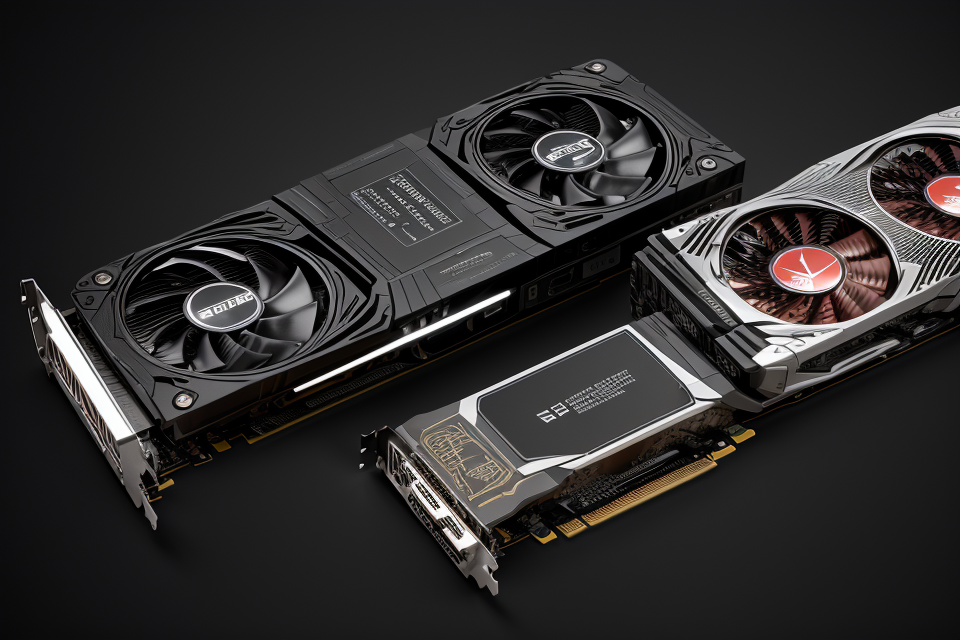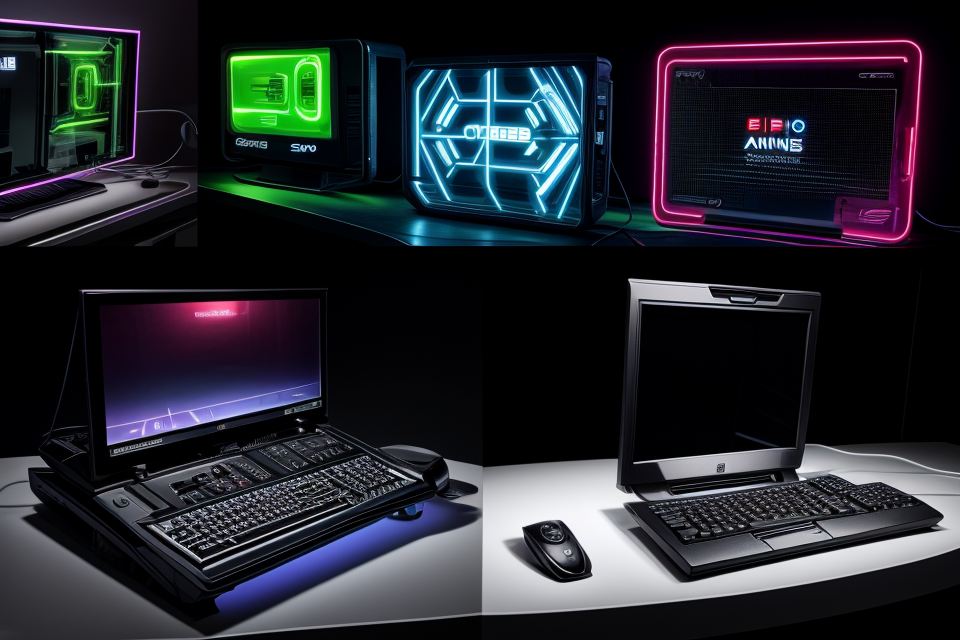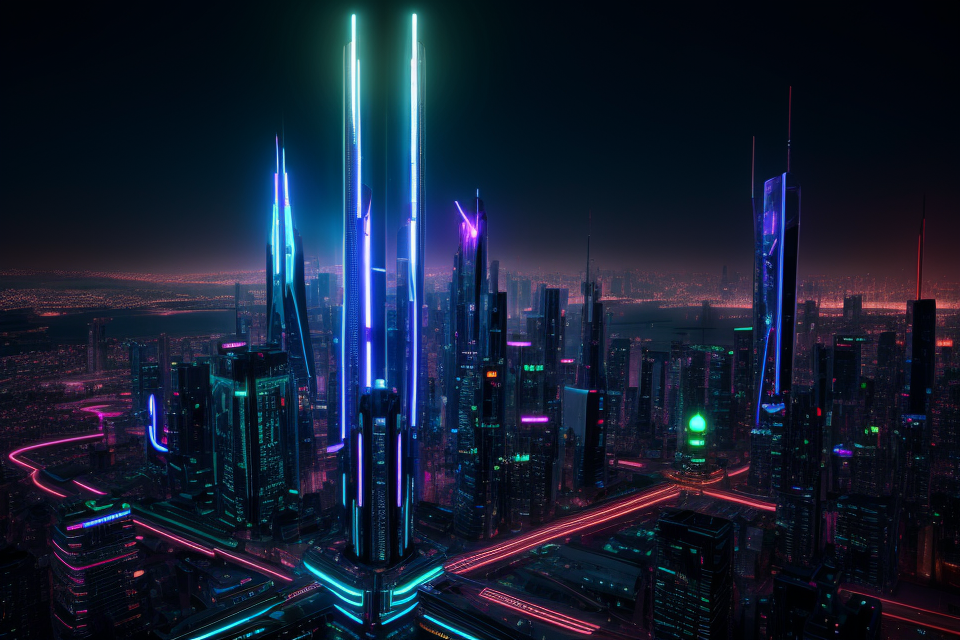
Are you a gaming enthusiast who dreams of owning the latest high-end graphics card? But do you ever wonder why these graphics cards come with a hefty price tag? The answer lies in the complex technology and advanced features that these graphics cards possess. From 4K resolution gaming to cutting-edge VR experiences, high-end graphics cards are designed to deliver unparalleled performance. In this article, we will explore the reasons behind the high cost of these graphics cards and what makes them worth the investment. So, buckle up and get ready to know why these graphics cards are worth their weight in gold!
High-end graphics cards, such as those used for gaming or professional applications, come with a hefty price tag due to the advanced technology and complex components required to produce them. These cards are designed to handle demanding workloads and provide high levels of performance, which requires expensive materials and manufacturing processes. Additionally, high-end graphics cards often have features such as multiple GPUs, high memory capacity, and advanced cooling systems, which add to their cost. Finally, the demand for high-end graphics cards is often limited, which can drive up prices due to scarcity. Overall, the combination of advanced technology, limited demand, and high performance requirements contribute to the high cost of high-end graphics cards.
Understanding the Purpose of High-End Graphics Cards
What are High-End Graphics Cards?
High-end graphics cards are specialized computer hardware components designed to handle the complex and demanding tasks required for graphics-intensive applications such as gaming, video editing, and 3D modeling. These cards are specifically designed to provide superior performance and advanced features that are not available in standard or entry-level graphics cards.
High-end graphics cards typically feature more powerful processors, larger memory capacities, and higher bandwidths than their lower-end counterparts. They also often include additional features such as support for multiple displays, hardware acceleration for specific applications, and advanced cooling systems to maintain optimal performance.
In addition to their technical specifications, high-end graphics cards are also typically designed with aesthetics in mind, featuring sleek and stylish designs that can enhance the overall look of a gaming or high-performance computer build.
Overall, high-end graphics cards are designed to provide the best possible performance and capabilities for demanding applications, and their premium price reflects the advanced technology and expert craftsmanship that goes into their development.
Why are they important?
High-end graphics cards are an essential component of modern computing systems. They are designed to handle complex graphical tasks, such as gaming, video editing, and 3D modeling, with ease. The importance of high-end graphics cards can be attributed to several factors, including:
- *Enhanced visual experience:* High-end graphics cards are capable of rendering images and videos with stunning clarity and detail. They provide a seamless and immersive visual experience, which is essential for tasks such as gaming, video editing, and 3D modeling.
- Increased performance: High-end graphics cards are designed to handle complex graphical tasks with ease. They are equipped with powerful processors and memory, which enable them to render images and videos faster and more efficiently than standard graphics cards. This increased performance is essential for tasks such as gaming, video editing, and 3D modeling, which require rapid and complex computations.
- Advanced features: High-end graphics cards come with advanced features such as ray tracing, which simulates the behavior of light in a scene, and DLSS, which uses artificial intelligence to enhance image quality while reducing the workload on the graphics card. These advanced features enable high-end graphics cards to provide a more realistic and immersive visual experience.
- Future-proofing: High-end graphics cards are designed to be future-proof, meaning they can handle the demands of new and emerging technologies. As technology continues to advance, the demand for more powerful graphics cards will increase. Investing in a high-end graphics card now can save money in the long run by eliminating the need to upgrade the card as new technologies emerge.
Overall, high-end graphics cards are an essential component of modern computing systems. They provide enhanced visual experience, increased performance, advanced features, and future-proofing, making them a worthwhile investment for those who require high-quality graphical performance.
The Factors Contributing to the High Cost of High-End Graphics Cards
Complex Design and Manufacturing Process
High-end graphics cards are complex pieces of technology that require intricate design and manufacturing processes. The development of these cards involves a range of specialized components and cutting-edge technologies, which contribute to their high cost. In this section, we will delve into the details of the complex design and manufacturing process that underlies the high price of high-end graphics cards.
Custom-designed Chips and Memory
High-end graphics cards are built with custom-designed chips and memory that are specifically tailored to meet the demands of intensive graphics applications. These chips and memory are designed to work in unison to deliver optimal performance, which requires significant investment in research and development.
Furthermore, these custom-designed chips and memory are typically fabricated using specialized manufacturing processes that are more expensive than those used for standard components. The process of designing and manufacturing these specialized components is complex and time-consuming, which contributes to the overall cost of the graphics card.
Cooling Systems
High-end graphics cards also require advanced cooling systems to prevent overheating and maintain optimal performance. These cooling systems are typically more complex and expensive than those found in standard graphics cards, as they must dissipate the heat generated by the powerful components.
Many high-end graphics cards utilize multiple fans or liquid cooling systems to efficiently dissipate heat. These cooling systems require precise engineering and high-quality components, which adds to the overall cost of the graphics card.
High-Quality Materials and Build Quality
High-end graphics cards are built with high-quality materials and are engineered to the highest standards of build quality. These cards are designed to withstand the demands of intensive graphics applications and to operate at high temperatures for extended periods.
The use of high-quality materials and precise construction techniques contributes to the overall cost of the graphics card. Additionally, the need for high-quality materials and construction techniques ensures that the card is built to last and can withstand the demands of even the most intensive graphics applications.
In conclusion, the complex design and manufacturing process of high-end graphics cards plays a significant role in their high cost. The custom-designed chips and memory, advanced cooling systems, and high-quality materials and build quality all contribute to the overall cost of these cards. Despite their high price, high-end graphics cards remain an essential component for those who require the highest levels of performance and reliability for their graphics applications.
Rare and Expensive Materials Used
The cost of high-end graphics cards is largely influenced by the use of rare and expensive materials. These materials are crucial in the production process, as they enable the card to function optimally and deliver high-quality graphics. Some of the materials used include:
1. Gold
Gold is a highly conductive metal that is often used in the production of high-end graphics cards. It is used to create the connectors that link the various components of the card together. The use of gold in these connectors ensures that the card operates smoothly and efficiently, which is crucial for delivering high-quality graphics.
2. Palladium
Palladium is another rare and expensive metal that is used in the production of high-end graphics cards. It is used to create the capacitors that store electrical charge in the card. The use of palladium in these capacitors ensures that the card can handle high levels of electrical current, which is essential for delivering smooth and seamless graphics.
3. Copper
Copper is a highly conductive metal that is used in the production of high-end graphics cards. It is used to create the heat pipes that dissipate heat from the card’s components. The use of copper in these heat pipes ensures that the card can operate at high speeds without overheating, which is crucial for delivering stable and reliable graphics.
These rare and expensive materials are used in small quantities but play a critical role in the performance of high-end graphics cards. The cost of these materials is often passed on to the consumer, resulting in the high price tag associated with these cards.
Limited Supply and High Demand
One of the primary reasons high-end graphics cards come with a hefty price tag is due to the limited supply and high demand for these products. This situation is a result of several interconnected factors, which contribute to the scarcity of high-end graphics cards in the market.
- High Manufacturing Costs: The production of high-end graphics cards requires the use of advanced technologies and specialized components, such as powerful GPUs and high-speed memory. These specialized components are often expensive to manufacture, which contributes to the overall cost of the graphics card.
- Research and Development: Developing cutting-edge graphics technology is a complex and resource-intensive process. Companies invest heavily in research and development to create new products that can outperform their competitors. This investment, along with the costs associated with designing and testing new products, is factored into the final price of the graphics card.
- Competition and Marketing: Graphics card manufacturers are constantly vying for market share, and this competition can drive up prices. In addition to the cost of developing new products, companies must also invest in marketing and advertising to promote their products. These costs are often passed on to the consumer in the form of a higher price tag.
- Limited Production Runs: High-end graphics cards are often produced in limited quantities, as the demand for these products is typically higher than the supply. This limited production can result in a higher cost per unit, as manufacturers may need to allocate more resources to producing these products.
- Cryptocurrency Mining: The surge in cryptocurrency mining has also contributed to the high demand for high-end graphics cards. Miners require powerful graphics cards to perform complex calculations, and this demand has caused a shortage of available cards for consumers. As a result, the price of high-end graphics cards has increased, making them more expensive for those who do not engage in mining activities.
In summary, the limited supply and high demand for high-end graphics cards are influenced by several factors, including manufacturing costs, research and development expenses, competition and marketing, limited production runs, and cryptocurrency mining. These factors combine to create a market dynamic where the price of high-end graphics cards remains high, making them a costly investment for consumers.
Cutting-Edge Technology and Research and Development Costs
The cost of high-end graphics cards is significantly influenced by the expenses associated with cutting-edge technology and research and development (R&D). Here are some factors that contribute to this cost:
- Innovative Design: High-end graphics cards are designed to be at the forefront of technological advancements. These innovative designs often incorporate new materials, manufacturing processes, and architecture that can be expensive to develop and implement.
- Complex Manufacturing Processes: The production of high-end graphics cards requires complex manufacturing processes, including the assembly of numerous components, testing, and quality control. These processes can be time-consuming and labor-intensive, contributing to the overall cost of the product.
- Advanced Features: High-end graphics cards often come with advanced features such as programmable shaders, high-speed memory, and efficient cooling systems. These features require additional research, development, and manufacturing costs, which are passed on to the consumer.
- R&D Investment: The development of new graphics card technology is a continuous process, requiring significant investment in R&D. Companies must invest in researching and developing new technologies, testing prototypes, and refining designs. These costs are passed on to the consumer through the pricing of the final product.
- Competition: The high-end graphics card market is highly competitive, with several major players vying for market share. To maintain their position in the market, companies must continually invest in R&D to develop new and innovative products. This constant competition drives up the cost of high-end graphics cards.
Overall, the high cost of high-end graphics cards is largely attributable to the significant investment required for cutting-edge technology and R&D. These costs are necessary to ensure that the final product is innovative, reliable, and competitive in the market.
The Impact of High-End Graphics Cards on the Market and Consumers
The Gaming Industry
High-end graphics cards have a significant impact on the gaming industry. The gaming industry relies heavily on graphics cards to deliver realistic and immersive gaming experiences. The high-end graphics cards provide gamers with the ability to run games at higher resolutions, faster frame rates, and with more detail than ever before. This allows gamers to experience more realistic and immersive gameplay, leading to a more enjoyable gaming experience.
Additionally, high-end graphics cards enable gamers to play the latest games with the highest visual quality settings. This means that gamers can experience the full potential of the game’s graphics, providing a more visually stunning experience. This is particularly important for gamers who prioritize the visual aspect of gaming, such as those who play first-person shooters or racing games.
The high-end graphics cards also allow for the use of advanced graphics techniques, such as ray tracing and advanced shading, which enhance the visual fidelity of the game. This provides a more realistic and immersive gaming experience, which is particularly important for gamers who value realism in their games.
Overall, the impact of high-end graphics cards on the gaming industry is significant. They provide gamers with the ability to experience more realistic and immersive gameplay, as well as the ability to play the latest games with the highest visual quality settings. This leads to a more enjoyable gaming experience for gamers who prioritize the visual aspect of gaming.
The Professional and Industrial Sectors
High-end graphics cards have a significant impact on the professional and industrial sectors, where they are used for various purposes such as engineering, architecture, medical imaging, scientific simulations, and other specialized applications. These sectors require powerful graphics processing units (GPUs) to handle complex tasks and processes that are beyond the capabilities of regular graphics cards.
The professional and industrial sectors are willing to pay a premium for high-end graphics cards because they provide a significant advantage in terms of performance, reliability, and productivity. For instance, in the engineering and architecture industries, high-end graphics cards are used for rendering complex 3D models and simulations, which require a lot of processing power. Similarly, in the medical imaging sector, high-end graphics cards are used for processing large amounts of data and generating high-quality images for diagnosis and treatment.
Moreover, high-end graphics cards are also used in scientific research and simulations, where they are required to perform complex calculations and modeling. These applications require a high level of precision and accuracy, which can only be achieved with powerful GPUs. As a result, the professional and industrial sectors are willing to pay a premium for high-end graphics cards to ensure that they have the necessary tools to perform their work efficiently and effectively.
In addition to their performance benefits, high-end graphics cards also offer a number of other advantages for the professional and industrial sectors. For example, they are often more reliable and durable than regular graphics cards, which makes them a good investment for businesses that rely on them for critical applications. They also offer a range of features and technologies that are tailored to the needs of professional users, such as support for multiple displays, high-speed memory, and specialized software tools.
Overall, the professional and industrial sectors are willing to pay a hefty price tag for high-end graphics cards because they provide a significant advantage in terms of performance, reliability, and productivity. These sectors require powerful GPUs to handle complex tasks and processes, and high-end graphics cards are the best option for meeting these needs.
The Future of High-End Graphics Cards
High-end graphics cards have become increasingly popular among gamers and professionals alike, who require advanced graphics processing capabilities for gaming, video editing, and other graphics-intensive applications. The demand for high-end graphics cards has been on the rise, leading to a significant increase in their prices.
The future of high-end graphics cards looks promising, with advancements in technology and the growing demand for better graphics processing capabilities. The following are some of the trends that are expected to shape the future of high-end graphics cards:
- Advancements in technology: With the constant advancements in technology, high-end graphics cards are expected to become more powerful and efficient. The next generation of graphics cards is expected to offer better performance, improved power efficiency, and new features such as real-time ray tracing and AI-based rendering. These advancements will make high-end graphics cards more desirable and valuable, driving up their prices.
- Growing demand for gaming and virtual reality: The gaming industry is expected to continue to grow, with the rise of virtual reality (VR) and augmented reality (AR) technologies. High-end graphics cards are essential for delivering an immersive gaming experience, and as more people adopt VR and AR devices, the demand for high-end graphics cards is likely to increase. This increase in demand will drive up their prices.
- Increasing use in professional applications: High-end graphics cards are not only popular among gamers but also among professionals who require advanced graphics processing capabilities for video editing, 3D modeling, and other graphics-intensive applications. As more professionals adopt high-end graphics cards, the demand for these cards is likely to increase, driving up their prices.
- Limited supply: The supply of high-end graphics cards is limited, as they require advanced manufacturing processes and rare materials. The limited supply of these cards means that their prices are likely to remain high, as demand outstrips supply.
In conclusion, the future of high-end graphics cards looks promising, with advancements in technology, growing demand for gaming and virtual reality, increasing use in professional applications, and limited supply driving up their prices. As technology continues to advance and demand for advanced graphics processing capabilities grows, high-end graphics cards are likely to remain a valuable and sought-after product in the market.
Final Thoughts on the Cost of High-End Graphics Cards
In conclusion, the cost of high-end graphics cards is largely influenced by market demand and technological advancements. The demand for high-end graphics cards is driven by various factors, including the increasing popularity of gaming, the rise of virtual reality, and the growing need for graphics processing power in professional applications.
Moreover, the high cost of high-end graphics cards can be attributed to the significant investment required to develop and manufacture these products. The development of new graphics card technology requires substantial research and development costs, as well as significant investments in manufacturing and assembly. Additionally, the production of high-end graphics cards often requires specialized equipment and skilled labor, further contributing to the overall cost.
However, despite the high cost, high-end graphics cards continue to be in high demand, particularly among gamers and professionals who require the highest levels of graphics processing power. While the cost may be prohibitive for some consumers, others are willing to pay the premium for the enhanced performance and capabilities offered by these products.
Overall, the cost of high-end graphics cards is largely determined by market demand and technological advancements, and while they may be expensive, they continue to be an essential component for many users who require the highest levels of graphics processing power.
FAQs
1. Why are high-end graphics cards so expensive?
High-end graphics cards are expensive due to the advanced technology and complex design required to produce them. The GPU (graphics processing unit) in a high-end graphics card is designed to handle complex mathematical calculations required for rendering images and video. The manufacturing process for these cards requires specialized equipment and skilled labor, which drives up the cost. Additionally, high-end graphics cards often come with additional features such as high memory capacity and advanced cooling systems, which also contribute to their high price.
2. Don’t cheaper graphics cards work just as well for gaming?
While cheaper graphics cards can be sufficient for basic gaming, high-end graphics cards offer significant performance advantages for demanding games and applications. High-end graphics cards have more powerful GPUs and higher memory capacity, which allows them to handle more complex graphics and rendering tasks. This results in smoother frame rates, better image quality, and a more immersive gaming experience.
3. Are high-end graphics cards worth the investment?
If you are a serious gamer or use your computer for demanding applications such as video editing or 3D modeling, a high-end graphics card can be a worthwhile investment. The performance benefits of a high-end graphics card can greatly enhance your gaming or professional experience. However, if you are on a tight budget or only use your computer for basic tasks, a cheaper graphics card may be sufficient.
4. How long do high-end graphics cards last?
The lifespan of a high-end graphics card depends on various factors such as usage, maintenance, and environmental conditions. With proper care and maintenance, a high-end graphics card can last for several years. However, as technology advances and new graphics cards are released, older models may become obsolete and no longer able to handle the latest games and applications. It is important to keep this in mind when deciding whether to invest in a high-end graphics card.


